“It seems once again that the burden of safe behavior is being placed entirely on pedestrians and bicyclists. Nothing is being asked of drivers.”
-Tiel Jackson, Portland Pedestrian Advisory Committee
When the Oregon Department of Transportation quietly released the news that they planned to shut down 181 crosswalks in the Portland metro area two weeks ago, people had a lot of questions — like which exact crosswalk legs were on the chopping block and why ODOT was making this decision. Transportation advocates were also confused and frustrated about the agency’s lack of transparency and public involvement in the process.
“There was no public process, no public notification, no public input of any kind. All of these crosswalk closures just started popping up,” said Tiel Jackson, co-chair of the Portland Pedestrian Advisory Committee (PAC) at a meeting earlier this week. “And that makes it really difficult to build a climate of trust with ODOT, especially with these other major projects that we have going forward.”
These “major projects” include the I-5 Rose Quarter expansion and subsequent plan to cap the freeway and reconnect north Portland’s Albina neighborhood, which has faced scrutiny and backlash for a long time. Given the particularly dangerous conditions for people biking and walking on ODOT-owned streets in Portland, transportation advocates are asking the agency to refocus their financial priorities away from increasing freeway capacity and toward making their streets safer.
To ODOT, these crosswalk closures are essentially a formality — the agency says the crosswalks they’re blocking off have been closed in essence long before now — and keeping them open would pose safety problems.
“The whole point of this is a safety question to make sure we’re directing pedestrians to the safety possible crossing at each state road. We don’t want people crossing at unsafe places across the highway,” ODOT Public Information Officer Don Hamilton said to BikePortland. “We want to make sure that they get to the safest possible crossing specifically on Powell Blvd, where we’ve had some problems in the past.”
Active transportation advocates say this strategy is misguided and puts the onus of safety on vulnerable road users instead of traffic engineers and planners who could make these streets safer with more ambitious — and less car-centric — redesigns. But ODOT is going ahead with their plan — many of the crosswalks are already closed. And without any pushback against ODOT from other local transportation agencies, it’s unclear what the path forward is for fighting these closures.
Reasons for closure
The initial information ODOT provided about the crosswalk closures was sparse in details, but the agency has now released a full list of crosswalk closures in Portland with specifics about which leg of the crossing will be closed and the criteria for the decision.
Some of the criteria ODOT outlines for closing these crosswalks include: median obstructions in the middle of the street with no cut-throughs; lack of pedestrian facilities or shoulders; inadequate sight distance for people driving to see people walking across the street and crossings aligned into driveways.
Portland Bureau of Transportation (PBOT) staff were caught off-guard by the announcement, as ODOT staff didn’t inform them about it ahead of time. But they ultimately came to the consensus that these criteria were acceptable and well-informed.
At a Pedestrian Advisory Committee (PAC) meeting this past Tuesday, PBOT Interim Pedestrian Coordinator Gena Gastaldi gave an update regarding PBOT’s temperature on the crosswalk closures.
“We didn’t know this was coming — we were not briefed on it beforehand, either. It came as just as much of a surprise to us as it did to everyone,” Gastaldi said. “What my colleagues and I found looking at the list of crossing closures is that a lot of them were just formalizing crossings that were already closed…I think there was some room for improvement with the unveiling or messaging around [ODOT’s decision], but from what we’ve all discussed at PBOT, these are all locations we would probably be closing as well.”
This may not be sufficient reasoning to people who have also criticized PBOT for closing crosswalks in the past.
Another reason ODOT cites for closing a crosswalk is if there’s a crossing nearby they deem safer that they want people to use instead.
This is the case for several crosswalk closures on Powell Blvd, including at 45th, 57th and 70th Aves. ODOT also cites this as a reason for closing the westerly crosswalk on Powell and 61st, an intersection due for an enhanced crosswalk on its eastern side through a TriMet plan. (ODOT has already shut down the western crosswalk at this intersection — but TriMet has yet to deliver on its planned crossing on the other side of the street. TriMet planners didn’t know about ODOT’s plan ahead of time.)
The ADA lawsuit
When ODOT announced their decision to close the crosswalks, they said it was a way to comply with Americans with Disabilities Act (ADA) curb ramp standards at crosswalks that are “unsafe and inaccessible.” But the decision raised eyebrows among people involved in the lawsuit, who thought it may have been ODOT’s attempt to get out of their legal responsibilities.
In 2016, a group of Oregonians sued ODOT, alleging the state hadn’t build ADA-compliant curb ramps while constructing and maintaining state highways. They later settled out of court. Per the settlement agreement, ODOT completed a survey of curb ramps on state highways and found that 97% of the 26,000 ramps they inspected didn’t meet ADA standards. Ten Oregon counties didn’t have a single compliant ramp.
According to the terms of the settlement, ODOT needed to remediate 7,770 curb ramps statewide by December 31, 2022 (30% of the total ramps that need work statewide). Per a 2021 audit report of the ADA Settlement Agreement (pdf), the agency had completed 3,744, leaving about 4000 more to be done in 2022.
Tom Stenson, a senior attorney with Disability Rights Oregon who has been involved in the lawsuit, believes part of why ODOT decided to close the 181 crosswalks is because they weren’t meeting the timeline for fixing the ramps, and he is skeptical about the other reasons the agency cited for the crosswalk closure plan.
“I think what’s troubling is under their own rules, they can’t just close a whole swath of crossings. There are actually pretty specific rules that they have to follow,” Stenson told BikePortland. “And it seems unlikely that they’ve been able to follow the very exacting requirements for closing in this context for hundreds of crosswalks in one go.”
Closing crosswalks is a legally acceptable way to comply with ADA requirements, and ODOT has done this to fulfill ADA standards at a variety of crossings across the state. But Stenson said he doesn’t think this is a good faith reading of the settlement agreement.
At the PAC meeting on Tuesday, Portland ADA Coordinator Lisa Strader — who was ODOT’s ADA Coordinator in the aftermath of the lawsuit settlement — offered a different perspective. She said the locations ODOT chose to close are genuinely unsafe and can’t be remedied, and many of them have already been closed for a long time. The formalizing of the closures is to meet the ADA settlement requirements, but not due to nefarious reasons.
“One of the ways that they can make a corner or the curb ramp compliant is by closing a crossing…ODOT recognized that they already had closers in place, but they didn’t have all the documentation because the process changed over time,” Strader said. “It’s mostly a clean-up process to be sure that they’ve formally done everything they need to do under their under their settlement agreement related to where they close a crosswalk and effectively then close the curb ramp.”
BikePortland reached out to ODOT’s communications team for a comment on the relationship between the settlement and the lawsuit, but haven’t heard back.
What advocates are thinking
A press statement issued last week from advocacy non-profit Oregon Walks states the organization’s intent to keep fighting these crosswalk closures.
“For pedestrians in Oregon, crossing the street is more dangerous than it has ever been. In just the month of January, three pedestrians in Portland were killed on streets that the public has begged ODOT and PBOT to make safer for years,” the statement reads. “Be assured that we are reviewing these closures and where appropriate will advocate for not only the reversal of the closures, but an investment in their improvement.”
Per Oregon law, a crosswalk exists at every public road intersection, whether or not it’s marked. Many of the crosswalks ODOT is closing are genuinely unsafe for a variety of reasons. But advocates still want to know why those problems couldn’t have been remediated instead of just shutting the crossings down entirely.
“It seems once again that the burden of safe behavior is being placed entirely on pedestrians and bicyclists. Nothing is being asked of drivers,” said PAC co-chair Tiel Jackson at Tuesday’s meeting. “What problem is this really trying to solve and it’s the best way to go about solving it? In what world does giving us fewer walking options actually make us safer?”
PAC member Mary Lee Turner, an accessibility advocate who is blind and uses a white cane to help her get around the city on foot, pointed out another safety concern about the crosswalk closures.
“What if I’m out there and I go across the street and the crosswalk is closed? How am I going to know it as a person traveling who’s blind?” Turner asked. “Now it’s getting even scarier [to walk in Portland].”
Jackson said the way ODOT went about this process is only contributing to the feelings of distrust many advocates have about the state transportation agency. Above everything else about the specific qualms with the crosswalk closures, this is the big takeaway many advocates appear to be getting from this situation.
“I started off very challenged with trusting ODOT,” Jackson said. “And I continue to be very challenged.”


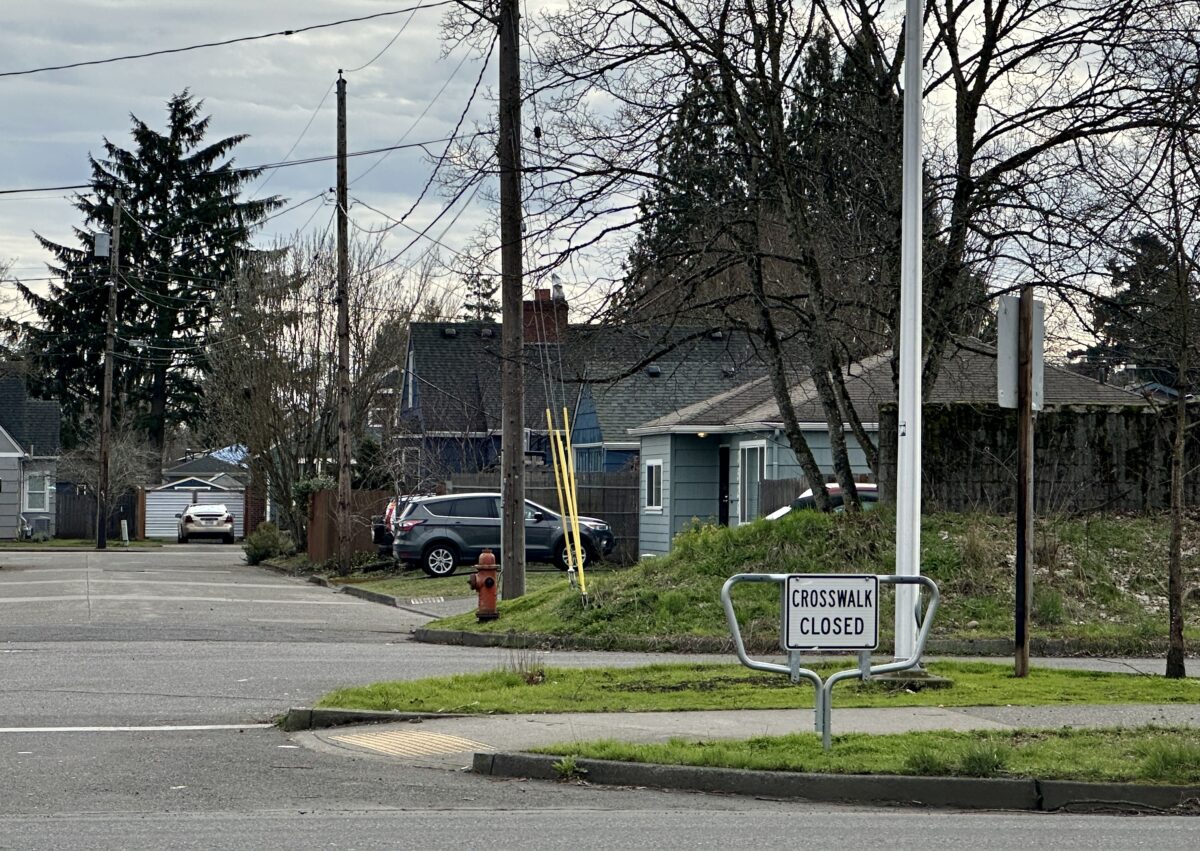

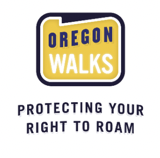
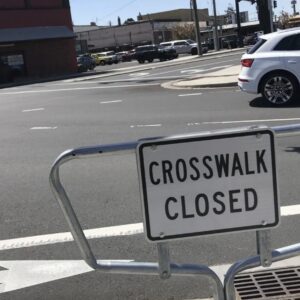
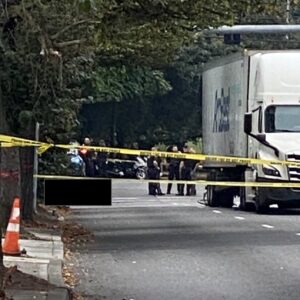
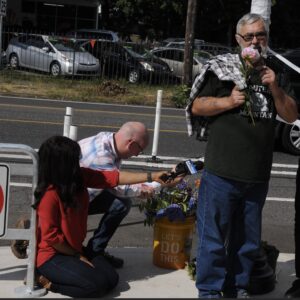
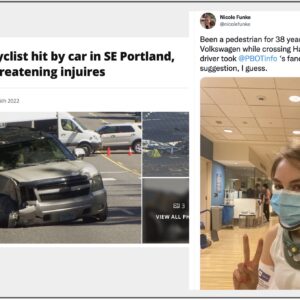
Thanks for reading.
BikePortland has served this community with independent community journalism since 2005. We rely on subscriptions from readers like you to survive. Your financial support is vital in keeping this valuable resource alive and well.
Please subscribe today to strengthen and expand our work.
I notice ODOT’s view is “To ODOT, these crosswalk closures are essentially a formality — the agency says the crosswalks they’re blocking off have been closed in essence long before now — and keeping them open would pose safety problems.”
“Closed in essence crosswalks” is a problematic concept. IF the ORS crosswalk definition (ORS 801.220) describes the crossing it IS a crosswalk, marked or unmarked. Crosswalk existence by statute definition does not somehow evaporate if ODOT does not like that spot to cross the roadway. ODOT needs to recognize from the outset that ANY closure of what would be otherwise be a legal crosswalk is a take back from the public way- it creates an illegal zone for crossing what would otherwise be a lawful spot to cross. ODOT does have legal authority to close crosswalks- they have that authority by law. BUT to start off by saying many of these now closed crosswalks were “closed in essence” beforehand fails to recognize they are pre-empting a public right to cross in a place that would otherwise meet the definition of a crosswalk. IF that place does not meet the crosswalk definition then it is a non-starter legally anyway and is no take away from anyone, unless it is a place that people use because they are desperate to find a decent way to cross the dang road. I wish ODOT would direct at least some of their efforts toward identifying those places historically used as crossings by folks trying to get across the road and concentrate some study and resources toward recognizing those natural crossings and working to create legal crosswalks and safety islands and signals with traffic control devices triggered to stop motorized traffic when a pedestrian is present..
I’m of the opinion that the Powell crossings could easily be made safer, rather than being formally closed. Milwaukie in particular is still a “major city walkway” and having the easterly leg closed is a major impediment to pedestrian mobility. I can’t tell you how annoying it is to have to cross three times in the name of keeping traffic flow up or whatever. More crossings means slower traffic means better pedestrian conditions. ODOT will never add/improve crossings because it would reduce level of service on the road. And “transportation” = “highways” still in Oregon unfortunately.
And is this just an administrative thing? Or are they going to install those signs? Because on narrow sidewalks next to highways, navigating around (frequently broken) signs is a genuine hazard.
To add back the missing east leg crosswalk, the entire signal would have to be rebuilt at a cost of several million dollars. I agree that they should do that, but it’s not like a simple, easy fix.
Nobody ever said it would be simple and easy.
As I’ve learned more, I’ve become less concerned. Many of these crossings really should be closed. A few may be worth fighting for, but it’s far from the number I thought when I originally saw the size of ODOT’s list.
I walk across the I-405 Kerby exit ramp crosswalk regularly. ODOT’s page says:
“Median obstruction in middle of highway with no cut-throughs.”
But the median has a cut-through (curb ramps). If the curb cuts aren’t up to modern ADA standards it would be easy to replace them, not close the crosswalk.
It’s on the walking route from PBOT’s Stanton St. Maintenance Yard to the New Seasons grocery store, so it would be nice to keep it open to allow walking options for their peers at PBOT for lunch.
The intersection has a stop sign for freeway exit ramp traffic, so it’s no problem using the crosswalk.
https://goo.gl/maps/RSia19U4bV8BrCBGA
I’ll send a request to AskODOT@odot.oregon.gov and ask them to keep it open, see if I get any clarification.
Ted Buehler
That looks like one that should be ensafened, not closed.
In the list, “westerly” for some reason is the term they use for “west leg”. So they’re talking about the west leg of that Kerby/I-405 ramp intersection, which has no curb ramps, a center median with no cut-throughs, and thus no pedestrian crossing. They’re not closing the crossing of the ramp itself, which would be the “northerly” leg.
It is embarrassing that there are not complete sidewalks on all sides of every street in downtown. The I-405/downtown interface is appallingly bad. IMO, PBOT should build out sidewalks and accessible curb ramps and send the bill to Gov Kotek/ODOT
I’m glad this is nowhere near as bad as the original announcement made it sound. Whoever ODOT’s PR person is really did a terrible job with that announcement; this is much more benign than it first appeared. I’d even go as far as to say it’s a complete non-story (that’s not a slight at any writer here, because based on the first announcement it appeared worthy of a large story indeed).
In some ways, this seems less bad than what PBOT is doing all over town. ODOT is closing existing deficient crosswalks, PBOT is closing crosswalks along streets they are rebuilding rather addressing the dangers from cars. A few egregious examples: SE Madison/1t2h, Outer Division, SW Naito/Morrison. I know people love to hate on ODOT, but PBOT is working just hard or harder to maintain car culture. There are excellent designers/engineers in both agencies, but judge them and pressure them by what they do, not what they say (PBOT is WAAAY better than ODOT at bikewashing projects)
For example, just look at the detour route indicated by PBOT for vulnerable road users who cannot use the stairs on the Bob Stacey Crossing when the elevators are so frequently out of order and a freight train is blocking the surface crossing of the tracks at SE Clinton and 12 Ave.
https://www.google.com/maps/d/u/2/viewer?mid=1zcDrC5hCUIgq9M3i4qYHu7hYJjb2kGot&ll=45.50104126488958%2C-122.65254175046279&z=20
Zoom in on this route and switch to satellite terrain photo and travel with your cursor along this route to get the full impact of how PBOT thinks it is ok to direct those in wheelchairs, with baby strollers, cargo bikes, adaptive cycles, etc. Clearly, whoever drew this route on the Google maps template has never walked or rolled this route in person.
PBOT would rather have those travelers cross back and forth over 5 lanes of state highway 26, and use the non-ADA underpass on the south side of Powell, than face any vulnerable-road-user backtalk about passing through the northside Powell RR underpass because it is a used by campers.
Maybe PBOT has not marked “officially closed” on that north side underpass MUP, but they make it clear that they view crossing back and forth over Powell Blvd. and using a non-ADA steep MUP underpass, as “safer” than traveling past people living in tents. If PBOT considers the relative danger to be greater to walk or roll past campers, they need to abate it. Instead, they send the most vulnerable of vulnerable road users on a route that is so much longer, has dangerous highway crossings, and includes ramps that are impassable for wheelchair users.
. ODOT is closing existing deficient crosswalks, instead fixing the intersections & bringing them up to ADA standards. Does it still sound less bad?
Yes, because PBOT is closing deficient crosswalks instead of fixing them an bringing them up to ADA standards AS A PART OF STREET DESIGN AND REBUILDING EFFORTS. At exactly the time when funds and crews are available to fix the crosswalk, PBOT is closing them instead.
I’m a strong believer in the principal that we should be improving intersections, rather than closing them.
There are on-the-ground realities that make this all a challenge, unless ODOT were to shift to a more inclusive, pedestrian friendly model and put a ton of money into it.
Many closed crosswalks cross stroads that are unsafe to begin with.
Many others have to do with offset streets.
Some would certainly require curb-cutting, which actually is expensive, unless ODOT were to loosen its contracting processes and its quality requirements. (An aside- the time for big infrastructure building projects was the previous decade, with its higher unemployment and lower interest rates, but the GOP screwed that opportunity for all of us).
I’ve lived near a few of these. Powell at 42nd is annoying because there are two cross streets (42nd and 43rd are offset), which legally should have four crossings. Instead, the intersection served by a single crosswalk with a beg button.
It’s a huge bummer.
“According to the terms of the settlement, ODOT needs to remediate 7,770 curb ramps statewide by December 31, 2022.”
Shouldn’t this be 2032?
The lawsuit was settled in 2016, and presumably they gave ODOT 6 years to fix everything, which the state naturally procrastinated on.
The PDF linked to in the same sentence says 2022. It does not appear to be a typo, although it is a jumble of a sentence. (The pdf, not BP)
It’s not a typo. ODOT agreed to a schedule to remediate around 27,000 curb ramps statewide by 2032. The agreement stated they’d have 30% (7,770) done by the end of 2022.
Ah, okay, that makes sense. It was confusing because it made it sound like they had already failed to meet the settlement.
I reworded it to hopefully make more sense.
They have.
I think advocates should shift their messaging away from just criticizing ODOT for following closing crosswalks, and instead focus on getting the legislature and the OTC to shift ODOT’s funding priorities from freeway projects to urban highway projects and interchange safety projects. That way they would have plenty of money to fix up these intersections and re-open closed crosswalks. It’s all about the money, folks.
You’re not wrong. ODOT even wants the city to take over these “orphan highways”, but no one has come up with the needed ~$30 million to bring them up to a state of good repair. Call your legislators!
Has either strategy been proven to work with ODOT?
I think it’s worth looking through every single one of these closure still. Some of them are pretty whatever (like the ones across 43 that lead to I5), but formally closing crosswalks at Burnside and 14th is really harmful to the pedestrian network. Yes, the crosswalks in question are already functionally closed – but at least the northerly leg across 14th really should be open. There is a huge and pointless quasi-slip lane (I say pointless because it doesn’t actually seem to assist in any movement – since 14th is one way NB and it’s on the NW leg of the intersection), and the signal timing should allow for a walk sign to be put up no problem – since there is a posted “no turns” on Burnside anyways.
Yes, the sidewalk on the bridge over 405 would need to be expanded. But that’s money well spent to improve the walking network in one of the most walkable parts of the city. It’s currently really annoying to get from the area around Crystal Ballroom to the areas of NW just north of Burnside – in no small part because this specific crosswalk closure forces a reroute or makes you know exactly when you need to cross Burnside. These are two of the more pleasant, walkable parts of the city that are like less than half a mile apart. It’s embarrassing and unacceptable.
Every single on-ramp to 405 is a nightmare to navigate, and closing the crosswalks makes it worse for pedestrians – not better. It’s already terrible to be so close to a freeway, but extra conflicts that are brought on by having to cross out of your way to get somewhere are also pretty dangerous. Drivers coming off the freeways are usually speeding and are used to “highway driving” – forcing more pedestrian interactions around that is bad!
comment of the week
How many unsafe car crossings has odot closed to motorists this year in Portland? Maybe every time there is a car crash we should close that road to drivers since obviously it’s not safe?
comment of the week
I have even more questions – why are places like NE Columbia Pkwy/89th and Lombard even on this list? There is no signal for peds, and they already have put up the dumb “Crossing Closed” signs. What more is required to close it? And why wasn’t that done when the signs went up? Seems pretty dumb to me
Any specific crosswalks on that list of 181 that someone really wants to use? Most of them look to run into huge retaining walls, across Jersey barriers along high speed portions of McLoughlin Blvd, or located within a few hundred feet of another crosswalk that has lots more safety treatments. Yes, more safe crossings that are safe enough for everyone to use would be great, but these crosswalks that are essentially already closed or somehow obstructed seem like bad candidates.
Most of the ones involving 405 should be opened still, and a few others here and there. It’s annoying to have to wade through a huge list that has roughly 50% very obvious closures, 25% seemingly already closed, 20% ehhh, 5% very awful decisions.
I know this is mostly off-topic here, but does anyone know why ODOT would plow Hwy 26 outside of Portland before they would plow it within the city limits?
I’m sorry I did not take screen shots at the time, but Wednesday night and Thursday morning when I looked on Tripcheck RoadCams, I saw that Hwy 26 appeared as bare pavement on its way up the mountain, while road cams in the high-pedestrian-motor-vehicle-crash/fatality sections in inner southeast appeared heavily covered with ice and snow.
Am I missing another reason why the Highway 26 section outside of town would be clear of snow and ice so much sooner than the section in town that affects so many more travelers using all modes, and thus being at a much higher risk of not just stranding travelers, but injuring or killing them?
It could be local weather conditions. I’m not really sure how much snow they actually got further west. The system more or less stalled over North/Central Portland, so it might have just been easier to clear up. Also, it’s easier to plow effectively on less busy roads since less ice will accumulate from cars compacting the snow, and fewer issues with traffic.
I would also think that ODOT probably keeps more of their winter weather removal stuff (trucks, salt, etc.) on and around the Cascade passes where they are needed more or less constantly all winter. It could be they plowed 26 west of Portland on the way into town.
I’m an ODOT hater, but I don’t think there’s anything nefarious going on. Plenty of incompetence though – considering the entire freeway system got closed down for quite a long time.
Blundrew is right about this! It wasn’t nearly as bad up there, and getting US26 plowed for ski traffic is a thing ODOT does near daily in the winter.
Not just ski traffic. 26 is a major commerce route. Mostly on weekdays, but also on weekends, you see a huge number of trucks using it, even during storms.
Yeah, I can answer that, from a lecture I heard years ago. When they rebuilt the highway many years ago, ODOT embedded magnetic metal strips along the edge of the highway that they then use to “guide” the plows even when the snow is so deep they can’t see the highway – the plows have a special sensor that uses these metal strips. A lot of European BRT systems use the same technology to keep buses driving in a straight line without having to use a guide rail.
PBOT just changed the route of the new 70s neighborhood greenway, and removed a planned protected crossing at 80th & Glisan. It’s been on the plans for years, but now they’ve moved the crossing to an existing crossing at 78th. That crossing has been missing a beacon & signage for over a year since cars keep running over the island and knocking them down.
“Were the 80th crossing improvements removed due to budget?”
Per the Project Manager:
“No, it was not about the budget. We just looked at the safer option for crossing. Due to heavier traffic on 80th/Glisan we chose 78th as a safer crossing. Some bikers could continue going on 80th if they feel comfortable but we wanted to route bikes through more local streets.”
Safety is a personal choice…?!
The truth is, if they added a new crossing and refuge island at 80th, it would make the 78th crossing even safer as cars would have (hopefully) already slowed down. Our roads need more crosswalks and more big chunks of concrete in them to slow drivers down and make pedestrians safer!
ODOT announces the closure of 181 roads to cars to increase human safety. “The whole point of this is a safety question to make sure we’re directing drivers to the safest possible transportation modes. We don’t want cars driving at unsafe places,” ODOT Public Information Officer Don Walker said to BikePortland in a parallel universe.
Yet another comment of the week.
This “public involvement” thing worked in the past, but not today. Increasingly getting the public involved is becoming more and more like a get together in a room full of The Three Stooges. People don’t know what they want. They just want to vent. Sometimes an agency simply has to go ahead and just do it, hope for the best, and change things if it doesn’t work out.
Some want to vent, but some have valuable input. I’ve seen several projects that welcomed public involvement make massive improvements to their designs because of that input. I’ve also been involved in several that skipped, limited, or ignored public input. Those turned out poorly, and some required expensive (thousands to millions of dollars) changes. At least two were deemed illegal (for reasons the public brought up before the projects proceeded) and ordered to be torn out–incredible wastes of money.
So “just do it, hope for the best, and change things if it doesn’t work out” isn’t a great motto for a public agency.
This bias toward kicking pedestrians in the teeth while giving automobilists a pass is reminiscent of the general misunderstandings back when ODOT was dragged kicking and screaming to take a look at Vision Zero (remember that?). We had plenty of conversations in these pages where folks pointed the finger at people walking and biking //in the name of Vision Zero// failing to appreciate that in other places, notably where Vision Zero was invented, they took/take a very different approach, recognize that the menace, the reason for Vision Zero in the first place, are not people using feet or pedals but people using steering wheels.
Whenever I read a quote by Don Hamilton, I usually fly into a rage. But this time I’m just confused. Did he actually say:
Can’t follow him there, though the rest of his quote is pretty triggering. He’s like the master of the bleedin’ obvious for someone who travels exclusively by car.
Business as usual then.
There are other ways of fixing these issues. Let’s take SE36th for example. Sure, the crossing is close to a Starbucks drive-thru, but how is this the pedestrian’s problem? Someone approved all these developments on both sides of the road with little attention to pedestrian and cyclist traffic. In fact, it seems like both assumed people will be arriving by car, even though there’s a huge e-bike store right there.
So basically, ODOT created the problems that they now say cannot be solved, along with the city of Portland that approved all this.
these ‘sidewalk closed’ signs that match the picture can sometimes be rotated- the ones that only have 1 point of contact with the ground. Occasionally they are rotated in a way that has them extending into the bike lane. Someday someone might get hurt and get them all ripped out
This Is reprehensible. No one should be forced to walk around an intersection, crossing streets three times, to get across one street. No driver would find it acceptable to drive around an entire block to access a parking lot that uses that block! How the ADA allows permanently closing *any* crosswalk is beyond me.
Every intersection should *have to* have a crosswalk (or sidewalk) on every single side. If the crossing isn’t safe, the street should have to be redesigned to make it safer.
This is 100% making society yield to the car, instead of demanding drivers live up to the responsibilities *they signed up for* when getting a license.